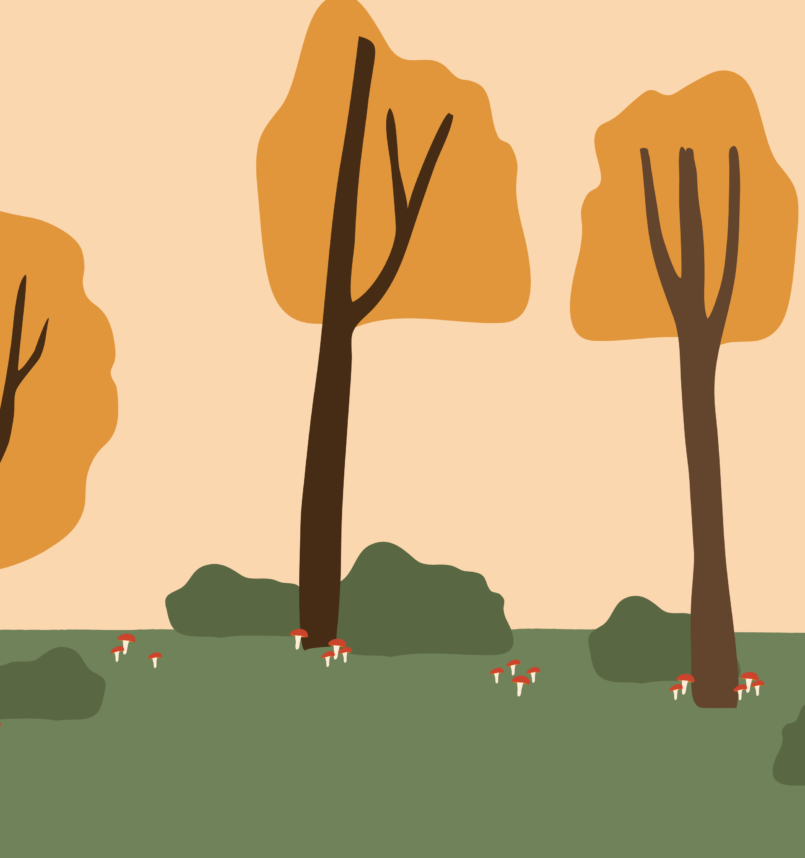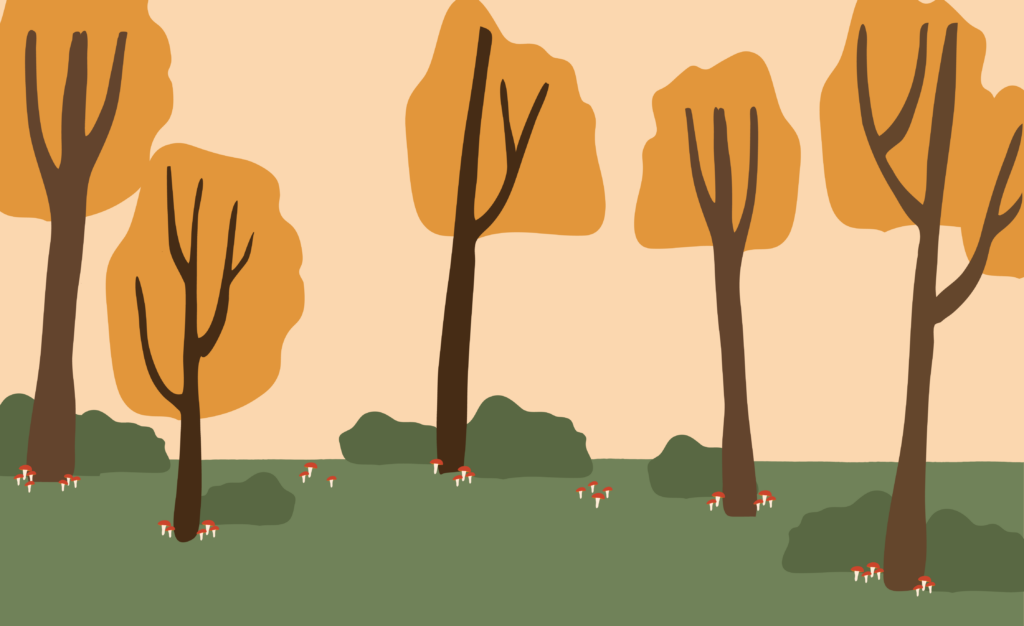WHAT LIES BENEATH by Bindy Pritchard

Standing as a sentinel at the front of my rented house is old man melaleuca, shedding flags of papery skin. I feel that this tree has existed forever. On one side of its thick trunk is a massive burl, a rucksack-shaped weight bulging from its body as if it’s been carrying a trauma for years. From the front verge, the leaves look green and healthy, but viewed from the house, it appears dead—its branches bleached-grey, clawed hands outstretched to the sky, beckoning for divine help.
I try not to get too connected to this tree. I pass it on walks with the dog, give it a cursory glance as I crawl up the long steep drive-way after school drop-off. This tree doesn’t belong to me so I don’t want to become overly invested in its charm. But actually, this tree has been perfect for our parties: Halloween, we’ve hung skeletons from the branches; Christmas, strings of coloured lights. Other creatures have found this tree useful too. This is the vantage spot for a family of magpies as they dive-bomb the postie in September. A golden orb spider has used this tree to affix a web to the smaller paperbark on the other side of the driveway, casting and recasting webs in the early hours of the morning, understanding (in that secret spidery way) that no traffic passes through at these hours. I know this because one morning before the sun rose, I woke in a great panic to wheel down the rubbish bin for collection day and heard a sickening THWACK where my giant forehead had headbutted the spider’s massive abdomen.
During Covid-19 lockdown, this tree has shown me yet more of its correlations into the world. I suddenly notice a stranger standing on the front verge and taking endless photographs of it. He confesses to me that he has photographed this tree over a thousand times in his life. It helps him adjust the settings on his camera, a lodestar for the recalibration of light and form. I like the idea of this man returning to the same tree over and over again in his quest for artistic perfection. It reminds me of the 1940s Hitchcock film, Rebecca, where Joan Fontaine’s character tells Mr De Winter about her artist father’s obsession: “He painted trees, at least it was one tree…You see, he had a theory that if you should find one perfect thing or place or person, you should stick to it.”
I have never regarded myself as being obsessive about the natural world, or indeed about anything. I’m moderate, contained, suburban. Many writers are obsessed with the natural world but not me. Certainly, I have set stories in the Western Australian countryside but, as a rule, I am more interested in writing about urban city landscapes, controlled environments in which my characters unravel.
But lockdown has caused nature to encroach upon my ordered world. Tendrils have creeped into the cracks. I crave daily walks with the family along the Djarlgarra river and at Piney Lakes Reserve. I find myself touching and stroking bark, and breathing in the mess of cockatoo-desecrated gum nuts. I am even drawn to nature via the online world. I follow a series in the Guardian newspaper called ‘Tree of the Week’, my favourite being the fallen elm in Hampstead Heath that looks like a “Man Ray nude”. I’ve walked the Heath many times on trips to London, but have no memories of any particular tree. But I do remember the surge of adrenalin firing my legs and giving me super human speed as I outran a male pursuer on a remote trail in 1995, and how the path wound into even denser thicket, making me feel like an animal being corralled into a dangerous snare. Back then though, the landscape was something for me to traverse urgently, it had no independent existence.
Now, nature takes centre stage even on my random internet browsing. Websites claim that dolphins are in the canals in Venice; wildlife has returned to the streets of London. Surely New York has remained resolutely urban. I click onto a YouTube link about a New York company, Dance Heginbotham, who have switched to online performance to share their art during a pandemic. The piece is called ‘You Look Like a Fun Guy’ and it takes me a minute to realise that the title is a pun on fungi. The dancers are moving through a grove of trees in the Brooklyn Botanical Gardens as a tribute to the obsession that the avant-garde composer John Cage had for mycology. This obsession led him to winning $10,000 on an Italian quiz show for a question about mushrooms. And this prize money was subsequently gifted to his partner Merce Cunningham to fund a tour bus for Cunningham’s famous dance company. There is an invisible network of mycorrhizal fungi beneath the dancers’ feet, a kind of underground internet, the “wood wide web” that shares nutrients and information with other living organisms. The two dancers capture this connectivity—they leap and twist lyrically, barefoot on the grass. I see hidden discipline and random bus journeys and the sheer joy of movement. You can hear the birdsong, whips of wind surging through the tree tunnel and the breakthrough wail of an ambulance siren.

Suddenly, I begin to get a ripple of excitement in my chest, that familiar signal that there is a story kernel there. Fungi are part of my own story, hidden for so long beneath my feet. I think about a childhood spent at my dad’s “weekender” an hour from Perth, and how, after the first rains of April, we invite our Willetton neighbours down for a day of mushrooming. There is my dad, standing in the greening paddock, giving a tutorial to all the novice mushroomers, speaking in that calm, professorial way of his. He shows them how to identify the edible mushrooms; what are the trademark traits of toadstools. And then after a morning of gathering, we return with our bounty in buckets, fingertips trilling with the pleasure of easing out delicate button caps from the damp earth. And there is one elderly neighbour who is a little dotty, her bucket full of glaring orange and white gilled fungi, twisted and garish hoods that scream out DANGER. And she proudly shows the bucket to my father and without missing a beat, he gently takes it from her and congratulates her, so that she looks just as radiant as the rest of us. And then another memory: my mother cooking a skillet of mushrooms on the woodfired stove, the spit of butter and crackle of jarrah warming the iron rafters of the small shed, my sister and brother huddled next to me giving off another type of warmth like small puppies.
I realise that the fungi are a metaphor for what fuels my own writing. The journey of fungi—its ability to work quietly underground to decompose and recycle nutrients for sustenance—this is how I, too, work. Not suburban in my preoccupations and obsessions, but focused on what lies beneath me; an inconspicuous underworld linking me to the pulsing heart of a story, connections spreading out like thirsty paperbark roots to the outermost regions of memory.
References
Rebecca 1940, Motion Picture, Selznick International Pictures, Hollywood
‘Tree of the Week’, The Guardian Newspaper https://www.theguardian.com/lifeandstyle/2020/may/25/tree-of-the-week-this-fallen-elm-looks-like-a-man-ray-nude
‘You Look Like A Fun Guy’, Dance Heginbotham at Brooklyn Botanical Gardens https://www.bbg.org/visit/art_in_the_garden
Bindy Pritchard lives and writes in Perth, on the traditional land of the Whadjuk people. Her fiction has been published in various journals such as Westerly, Review of Australian Fiction and Kill Your Darlings. Her debut story collection Fabulous Lives (Margaret River Press) was shortlisted for the 2019 Western Australian Premier’s Prize for an Emerging Writer.
Copyright © 2020 Bindy Pritchard.
This story and corresponding images have been licensed to the Centre for Stories by the Storyteller. For reproduction and distribution of this story/image please contact the Centre for Stories.
This story was published on 23 September 2020.